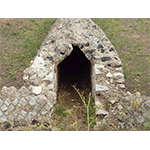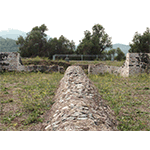Roman Villa of the Grottoes
On the promontory that bounds the Gulf of Portoferraio on the southeast, rise the remains of an ancient Roman villa that can be dated between the 1st century B.C. and the 1st century A.D. Partially destroyed to make room for artillery batteries during the conflicts between France and the Kingdom of Naples from 1799 to 1801, the villa still exerts a strong attraction also for the spectacular scenographic backdrop. The surviving structures reveal an original plan in opus reticulatum (small pyramidal tufa blocks laid in cement and arranged with the base facing outward, so as to form a reticulation) with a great visual impact, thanks to the alternation of red tiles, grey calcareous stones and green ophiolite.
Built in part on manmade substructions, the inhabited nucleus of the villa developed along a central axis formed by a large rectangular-shaped pool. Receiving water from a cistern sited above, the pool was bounded on three sides by a large space which must have been a garden. The conduit that crosses the basin lengthwise and stretches to the underlying terrace with a nymphaeum is still well-preserved. A small granite pier found in the promontory cove must have served as a berth for approaching the villa from the sea.
The remains of a baths quarter with frigidarium and calidarium date to a later period. Equipped with a double floor and suspensurae (terracotta pillarets supporting the floor to permit hot air to circulate beneath), according to excavation finds, in the middle of the calidarium there was a marble basin supported by a pillaret for cold ablutions.
****************************
Texts by Elena Fani
English translation by Victor Beard
Last update 26/feb/2008





